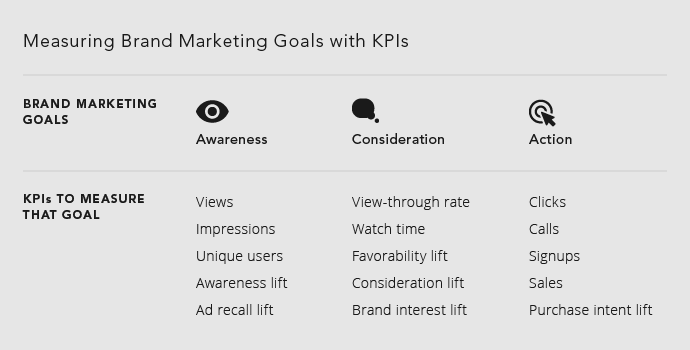Video Metrics: 17 KPIs You Need to Measure

Where a runaway viral video hit might leave you thinking your video marketing is a success, “viral videos” are rarer than you think. And just because your video marketing doesn’t get millions of views doesn’t mean it’s a failure. View counts or likes shouldn’t be the only metric you track to determine your video’s success - in fact, those metrics rarely correlate directly to measuring return on investment (ROI).
Instead, there is a handful of important metrics that can better help you determine how successful your video marketing is. These key performance indicators (KPIs) relate to the overall marketing goal you’re setting out to achieve. Let’s dive in.
Determining the Right KPIs Depending on Your Marketing Goal
In order to have a successful video marketing strategy, you first need to determine the goal of your video marketing efforts as it relates to your larger marketing plan. While the overarching goal of most marketing plans is to get more business, in order to do so, you must isolate which stage of your buyer’s journey needs to be improved in order to turn more leads into paying customers.
For example, sometimes that means attracting more leads during the awareness stage. Maybe you have those leads, but you need to better engage with them in order to keep them interested in your product during the consideration stage. Or you may need to better nurture them during the decision stage to make them comfortable enough to finally make a purchase.
The best way to think about activating video marketing is by determining what stage of this marketing funnel you’re trying to improve, and plan your content, goals, and KPIs around that.
To best illustrate this point, here’s a breakdown of what KPIs you should measure based on your marketing goal.

Goal 1 - Attracting New Leads
If your video marketing goal is to attract more leads during the awareness stage, then you should be measuring:
Ad recall lift: Determined through consumer research, this number is an aggregate based on how many viewers remember your video ad after a set number of days have passed. If a viewer watches your video for longer, it usually correlates to a higher lift in ad recall.
Awareness lift: Also determined through consumer research, this is an average based on the number of viewers who remember your brand after a set period of time. By measuring this KPI, you should see a lift in the amount of people who remember your brand or product.
Impressions: Tracking impressions will determine how many viewers have been introduced to your brand. However, an impression is only counted after the first frame of a video is seen - so autoplays in a newsfeed, even if they’re quickly scrolled past, count as an impression.
Unique users: More specific than impressions, unique users will help you measure the difference between total impressions and the actual total number of people who have seen your video. This is also good for determining levels of interest in the consideration stage - if you have a high number of views, but a lower number of unique users, that means the same viewers are watching your video multiple times.
Video Views: Lastly, tracking views are important if you’re trying to attract more leads. In a purely numeric sense, the more views a video has, the more leads have been introduced to your brand and product. Different video hosting platforms count views differently - for example, a YouTube video is considered viewed after someone has seen over 30 seconds, while Facebook and Instagram count views after just three seconds.
Goal 2 - Engaging with Prospects
If your goal is to better engage prospects who visit your owned channels during the consideration stage, the KPIs to measure are:
Brand interest lift: How interested are your prospects in your brand? Measure your brand interest lift, which is just the aggregate increase in interest in your brand, through taking visitor questionnaires and tracking increases in interactions or brand-related search queries. This will help determine how engaging the video content you use on your owned channels are.
Consideration lift: Especially useful for measuring the effectiveness of an individual video, this KPI is an estimate of the likelihood of conversions after viewers watch a specific video. This will help you break down which videos are more engaging than others if you have multiple videos on a website or landing page, for example. You can determine this number through undertaking consumer research.
Favorability lift: Similar to consideration lift, favorability lift tracks whether or not viewers see your brand more favorably after watching a specific video. Trackable through perception and video ad experience surveys, you should measure this KPI to determine both the difference in lifts in favorability among multiple videos, as well as overall across all your video content.
View-through rate: View-through rate tracks how many viewers watch the entirety of a video, which helps determine how engaging a video is. If the view-through rate is higher, that means the entire video is engaging; if the rate is lower, it means the video is not successful in engaging audiences.
Watch time: Similar to the view-through rate, the watch time metric is the total amount of time a video has been watched. Video hosting platforms like YouTube will add up the minutes cumulatively and prioritize videos with higher watch times. Pair this with the average view duration, which is the average amount of time that viewers watch your video, and you can determine how successful your video is at engaging viewers.
Goal 3 - Nurturing Decisions to Buy
If you find yourself trying to increase purchases during the decision stage, then your video marketing should aim to nurture prospects into paying customers by providing additional value and information to them. During this stage, you’ll want to measure these KPIs:
Click-through rate: The click-through rate (CTR) is great for determining how good a video is at nurturing would-be customers. As you measure your CTR across multiple videos, you can better determine how well the video assuages a viewer’s doubts or fears and persuades them to click through.
Calls and sign-ups: By measuring the number of calls or sign-ups, you can see your prospective customer’s level of interest in learning more about your product or service. To measure this, provide the appropriate contact information, and once they reach out, provide a lead capture form (or do so over the phone) so you can continue to nurture them until they decide to buy.
Purchase intent lift: By polling captured leads as part of a survey or questionnaire, you can measure the lift in purchase intent from any video marketing you provide during the decision stage. Nurturing videos are usually sent as part of newsletters or email requests for more information, so include a survey to measure this KPI after they watch a video to measure how successful that individual video is.
Sales: While obvious, measuring the exact number of sales before or after you send a video to leads during the decision stage will help you measure if that video contributed to an increase of sales. While sales don’t always happen immediately after a lead watches a marketing video, as long as you’re properly tracking a lead’s behavior at every touch point and building a reliable attribution model, you should be able to measure the impact of a marketing video compared to other efforts during this stage.
Bonus Goal: Delight Repeat Customers
After a customer makes a decision to buy, they enter the fourth stage of your marketing funnel, known as the retention stage. In this stage, you’re trying to delight your customers into purchasing again. To do so, you need to continue to add value long after your customers have purchased your product or service.
The KPIs to watch during this stage include:
Favorability lift: You should measure lifts in favorability both in the consideration and retention stage. By providing value to your customers with additional video content, like tips and trips, tutorials, or post-purchase FAQs, you should see brand favorability increase.
Return visits: After sharing videos through retargeting ads on social media or through customer email lists, measure any return visits to your website and landing pages from non-unique users. By tracking your customer’s behavior properly, you should be able to associate any jumps in return visits directly after a new video is sent out to determine how successful it is.
Social interaction: Since customers are more likely to interact with a brand on social media after purchasing, social interactions are a good way to determine if your video content is delighting customers into purchases again. Your company’s social channels will be one of the first places a customer goes to post a positive (or negative) review, so watch your comments, follower count, and shares after posting a particular video. More shares and positive comments following a new video can help measure how “delighted” a video makes customers.
In Conclusion
When measuring video marketing success, it’s all about attributing the right KPI to the correct goal. If you’re tracking the wrong metric based on what goal you’re hoping to reach, you won’t have an accurate reading of how well your video marketing is doing. Video production can be expensive and lucrative depending on who you work with, so make sure you take the time to track the right KPI and get the most out of your investment.
And if you’re looking for an analytics platform to help you track all of these KPIs, we recommend working with Google Analytics and/or Kissmetrics. Both of these will provide insights into a majority of the data-types listed above, and for those that aren’t as easily trackable, like lifts in favorability, purchase interest, and brand recall, consumer research and customer surveys should help fill in the gaps.
Ready to automate your reporting?
Read More
Don’t miss out!
Automate your reports!
Bring all your marketing data into one automated report.
Try dashthis for free

